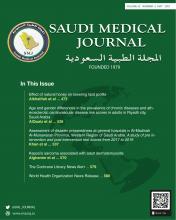Article Figures & Data
Tables
Characteristics n (%) Age, years <20 790 (16.1) 21-30 2088 (42.5) 31-40 783 (15.9) 41-50 828 (16.8) 50+ 425 (8.6) Gender Male 2865 (58.3) Female 2049 (41.7) Educational level Secondary or below 1251 (25.5) University student 1603 (32.6) University/above 2060 (41.9) Monthly income, SAR <5000 2466 (50.2) 5000-10000 1155 (23.5) >10000 1293 (26.3) Marital status Single 2483 (50.5) Married 2280 (46.4) Divorced/widowed 151 (3.1) Trained as first responder Yes 941 (19.1) No 3973 (80.9) - Table 2
- Public awareness of the correct response to cervical spine trauma among Saudi Arabia residents.
Response n (% Cervical injury risk factors RTA 3695 (75.2) Sports 99 (2.0) Inflammation 208 (4.2) Tumor 123 (2.5) Long use of devices 10 (0.2) Incorrect sitting posture 6 (0.1) Fall 5 (0.1) Do not know 768 (15.6) Is it possible for a cervical spine injury to be accompanied by damage to the spinal cord? Yes 3900 (79.4) No 84 (1.7) Do not know 930 (18.9) Can injuries to the cervical spine lead to life-long disability? Yes 3502 (71.3) No 222 (4.5) Do not know 1190 (24.2) Complications of cervical injury Motor disability 2559 (52.1) Sensory disability 1918 (39.0) Affected breathing 1414 (28.8) Urine incontinence 1191 (24.2) Stool incontinence 1132 (23.0) Smell & taste problems 386 (7.9) Do not know 2249 (45.8) May a patient with cervical spine injury require medical and physical management for their whole life? Yes 2707 (55.1) No 624 (12.7) Do not know 1583 (32.2) The first management for cervical spine injury patient Minimizing movement during transport 1838 (37.4) Changing patient position 84 (1.7) Call emergency services 2304 (46.9) Do not know 688 (14.0) Early prediction of cervical spine injury will help in preventing complications Yes 3818 (77.7) No 179 (3.6) Do not know 917 (18.7) Proper management at accident cite may prevent permanent spinal cord damage Yes 3292 (68.4) No 371 (7.7) Do not know 1153 (23.9) To safely stabilize a patient requires which of the following Keeping the patient same position if the place is safe until emergency services arrive 3582 (72.9) Correct deformity pulls arms neck and Legs 398 (8.1) Set patient up 41 (0.8) Do not know 893 (18.2) How would you respond should the patient require resuscitation? Call emergency services, start resuscitation, ensuring spine immobilization 4243 (86.3) Transport patient to nearest hospital in my vehicle 83 (1.7) Do nothing 91 (1.8) Do not know 497 (10.1) Which of the following signs may be indicative of a cervical cord injury? Unable to move hand 1618 (32.9) Pain in arms 770 (15.7) Numbness 1195 (24.3) Neck deformity 629 (12.8) All of the above 2989 (60.8) Do not know 68 (1.4) Which of the following diseases may increase the risk of cervical spine injury? Down’s syndrome 745 (15.2) Rheumatoid arthritis 3660 (74.5) Diabetes milieus 818 (16.6) Obesity 2060 (41.9) Overall awareness level Poor 3349 (68.2) Good 1565 (31.8) RTA: road traffic accidents
- Table 3
- Self-reported first responses to witnessed cervical spine injury among Saudi Arabia residents.
Responses n (%) I will help people involved in a car accident or fall Yes 3614 (73.5) No 1300 (26.5) A proper response can help the victim Yes 4197 (85.4) No 113 (2.3) Do not know 604 (12.3) Cervical spine injury can affect patient quality of life until death Yes 3501 (71.2) No 274 (5.6) Do not know 1139 (23.2) I would take spinal movement precaution in an unconscious trauma patient Yes 4047 (82.4) No 867 (17.6) I will try not to move the patient and call emergency services Yes 4573 (93.1) No 122 (2.5) Do not know 219 (4.5) I will call emergency services before beginning first aid intervention Yes 4171 (84.9) No 743 (15.1) I will take extreme care at all times to maintain the alignment of the head, neck and spine Yes 4717 (96.0) No 197 (4.0) If the patient is responsive and I suspect cervical spine injury I will do the following Reassure them and tell them to remain still 4119 (83.8) Check their neck mobility 249 (5.1) Try to change their position 54 (1.1) Do not know 492 (10.0) - Table 4
- Levels of public awareness regarding cervical spine trauma, stratified by survey participant demographic characteristics
Awareness level Variables Poor Good P-value Age, years <20 663 (72.9) 127 (16.1) 0.001* 21-31 1593 (76.3) 495 (23.7) 31-40 576 (73.6) 207 (26.4) 41-50 340 (41.1) 488 (58.9) 50+ 177 (41.6) 248 (58.4) Gender Male 1624 (59.7) 1241 (43.3) 0.001* Female 1725 (84.2) 324 (15.8) Educational level Secondary or below 860 (68.7) 391 (31.3) 0.002* University student 1273 (79.4) 330 (20.6) University/above 1216 (59.0) 844 (41.0) Monthly income, Saudi Riyals <5000 1970 (79.9) 496 (20.1) 0.001* 5000-10000 747 (64.7) 408 (35.3) >10000 632 (48.9) 661 (51.1) Marital status Single 1918 (77.2) 565 (22.8) 0.058* Married 1339 (58.3) 941 (41.3) Divorced/widowed 92 (60.9) 59 (39.1) Trained as first responder Yes 27 (2.9) 914 (97.1) 0.001 No 3322 (83.6) 651 (16.4) Values are presented as number and percentage (%). Comparisons were performed with the Pearson x2 test. *P-value of <0.05 was considered indicative of a statistically significant difference.






